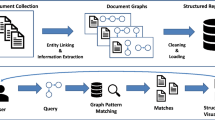Abstract
An important part of the scientific discourse is the exchange of knowledge in the form of stringent, well-arranged, and interconnected arguments. These ‘scientific storylines’ allow to put central entities, observations, experiments, etc. into perspective and thus ease the understanding of underlying mechanisms, dependencies, or theories. Moreover, taking a bird’s eye view allows to discern recurring narrative patterns that have proven helpful for validating, comparing, and fusing information across individual publications and even between disciplines. However, current knowledge repositories still struggle with representing such information in a structured way. This is because narratives do not only contain factual bits of information, but also parts like temporal developments, causal dependencies, etc. In this paper, we present an innovative conceptual model using a logical overlay structure to bridge the gaps between individual types of knowledge repositories. We also explain how narrative bindings validate modeled narratives in the sense of provenance. In brief, narrative overlays plus adequate bindings allow to effectively fuse knowledge and improve retrieval and discovery tasks by structurally aligning underlying repositories only driven by some narrative. Finally, we practically demonstrate the usefulness of our model by applying it to a scientific narrative in the PubMed bio-medical collection.
Access this chapter
Tax calculation will be finalised at checkout
Purchases are for personal use only
Similar content being viewed by others
References
Auer, S., Kovtun, V., Prinz, M., Kasprzik, A., Stocker, M., Vidal, M.E.: Towards a knowledge graph for science. In: Proceedings of the 8th International Conference on Web Intelligence, Mining and Semantics, pp. 1–6, WIMS 2018, ACM (2018). https://doi.org/10.1145/3227609.3227689
Chambers, N., Jurafsky, D.: Unsupervised learning of narrative event chains. In: Proceedings of ACL-08: HLT, pp. 789–797 (2008)
Chang, D.-S., Choi, K.-S.: Causal relation extraction using cue phrase and lexical pair probabilities. In: Su, K.-Y., Tsujii, J., Lee, J.-H., Kwong, O.Y. (eds.) IJCNLP 2004. LNCS (LNAI), vol. 3248, pp. 61–70. Springer, Heidelberg (2005). https://doi.org/10.1007/978-3-540-30211-7_7
Habernal, I., Gurevych, I.: Argumentation mining in user-generated web discourse. Comput. Linguist. 43, 125–179 (2017). https://doi.org/10.1162/COLI_a_00276
Hauser, M.D., Chomsky, N., Fitch, W.T.: The faculty of language: what is it, who has it, and how did it evolve? Science 298, 1569–1579 (2002). https://doi.org/10.1126/science.298.5598.1569
Hernández, D., Hogan, A., Krötzsch, M.: Reifying RDF: what works well with wikidata? In: Proceedings of the 11th International Workshop on Scalable Semantic Web Knowledge Base Systems, CEUR Workshop Proceedings, vol. 1457, pp. 32–47. CEUR-WS.org (2015)
Kroll, H., Kalo, J.-C., Nagel, D., Mennicke, S., Balke, W.-T.: Context-compatible information fusion for scientific knowledge graphs. In: Hall, M., Merčun, T., Risse, T., Duchateau, F. (eds.) TPDL 2020. LNCS, vol. 12246, pp. 33–47. Springer, Cham (2020). https://doi.org/10.1007/978-3-030-54956-5_3
Li, B., Lee-Urban, S., Johnston, G., Riedl, M.: Story generation with crowdsourced plot graphs. In: 27th AAAI Conference on Artificial Intelligence (2013). https://doi.org/10.5555/2891460.2891543
Manola, F., Miller, E., McBride, B., et al.: Rdf primer. W3C recommendation 10(1–107), p. 6 (2004)
Mochales, R., Moens, M.F.: Argumentation mining. Artif. Intell. Law 19, 1–22 (2011). https://doi.org/10.1007/s10506-010-9104-x
Nguyen, V., Bodenreider, O., Sheth, A.: Don’t like RDF reification?: making statements about statements using singleton property. In: Proceedings of the 23rd International Conference on World Wide Web, pp. 759–770, WWW 2014, ACM (2014). https://doi.org/10.1145/2566486.2567973
Spangler, S., Wilkins, A.D., Bachman, B.J., Nagarajan, M., Dayaram, T., Haas, P., et al.: Automated hypothesis generation based on mining scientific literature. In: Proceedings of the 20th ACM SIGKDD International Conference on Knowledge Discovery and Data Mining, pp. 1877–1886. KDD 2014, ACM (2014). https://doi.org/10.1145/2623330.2623667
Toulmin, S.E.: The Uses of Argument. Cambridge University Press, Cambridge (1958)
Wylot, M., Cudré-Mauroux, P., Hauswirth, M., Groth, P.: Storing, tracking, and querying provenance in linked data. IEEE Trans. Knowl. Data Eng. 29, 1751–1764 (2017). https://doi.org/10.1109/TKDE.2017.2690299
Author information
Authors and Affiliations
Corresponding author
Editor information
Editors and Affiliations
Rights and permissions
Copyright information
© 2020 Springer Nature Switzerland AG
About this paper
Cite this paper
Kroll, H., Nagel, D., Balke, WT. (2020). Modeling Narrative Structures in Logical Overlays on Top of Knowledge Repositories. In: Dobbie, G., Frank, U., Kappel, G., Liddle, S.W., Mayr, H.C. (eds) Conceptual Modeling. ER 2020. Lecture Notes in Computer Science(), vol 12400. Springer, Cham. https://doi.org/10.1007/978-3-030-62522-1_18
Download citation
DOI: https://doi.org/10.1007/978-3-030-62522-1_18
Published:
Publisher Name: Springer, Cham
Print ISBN: 978-3-030-62521-4
Online ISBN: 978-3-030-62522-1
eBook Packages: Computer ScienceComputer Science (R0)




